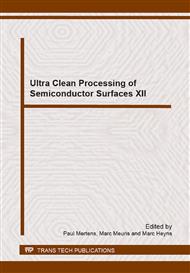p.28
p.32
p.36
p.40
p.47
p.52
p.56
p.59
p.63
InGaAs (110) Surface Cleaning Using Atomic Hydrogen
Abstract:
A major obstacle facing III-V semiconductor based metal oxide semiconductor field effect transistors (MOSFETs) is the large density of trap states that exist at the semiconductor/oxide interface.[1] These trap states can pin the Fermi level preventing the MOSFET from acting as a switch in logic devices. Several sources of Fermi level pinning have been proposed including oxidation of the III-V substrate.[2, 3] In order to minimize the presence of III-V oxides it is crucial to employ either an ex-situ etch or to use an in-situ method such as atomic hydrogen cleaning.[4, 5] Although atomic H cleaning of III-V surfaces is well known, it has never been demonstrated on InGaAs (110) crystallographic faces. Furthermore, tri-gate field effect transistors (finFETs) have recently been employed in commercially available logic chips.[6] This unique device architecture allows for a reduction in short channel effects, minimization of the subthreshold swing, and a higher transconductance.[7] The InGaAs (110) surface would be the sidewalls of a vertically aligned (001) based finFETs.[8] Therefore, it is essential to find an in-situ method to efficiently remove any oxides or contamination from the (110) surfaces that is also compatible with the (001) surface. In this study, STM was employed to determine if atomic hydrogen can be used to remove the native oxide from air exposed InGaAs (110) samples. A post clean anneal was used to restore the surface to molecular beam epitaxy (MBE) levels of cleanliness.
Info:
Periodical:
Pages:
47-51
Citation:
Online since:
September 2014
Authors:
Price:
Сopyright:
© 2015 Trans Tech Publications Ltd. All Rights Reserved
Share:
Citation:


